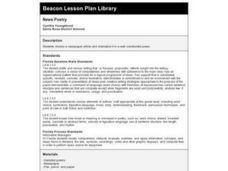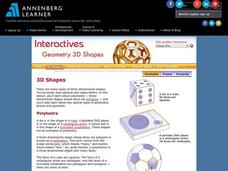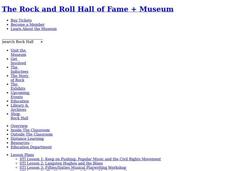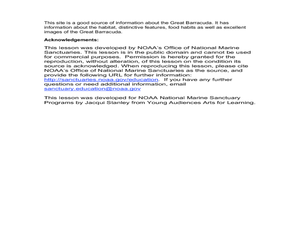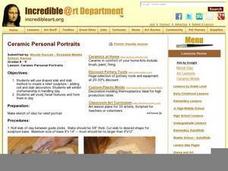Curated OER
News Poetry
Third graders select a small item in a newspaper and then dramatize it in a well-constructed poem. They share their poems with the class.
Curated OER
Mixing Races in New Orleans
Students discuss the changes in the legal, social, and political status of African Americans and those of mixed ethnicity after reading the narrative, Haitian Immigration: Eighteenth and Nineteenth Centuries.
Curated OER
Jazz: Expression through Improvisation
Students watch a video on improvisation. They improvise original melodies over given chord progressions. They develop criteria to evaluate the merits of improvisational performances and apply the criteria in their personal listening and...
Curated OER
The Important Poem
Students are read numerous examples of strong poetry. Individually, they brainstorm a list of interests or attributes about themselves and choose the most important one. They write a poem using the attribute and shares the poem with the...
Curated OER
Enslaved and Running
Young scholars use runaway slave advertisements to discover how the language varies from the 18th to 21st century. Using primary source documents, they research the brutality of slavery and the desire of those in slavery to be free. ...
Curated OER
Social Studies: What Is Folklife?
Students read an essay about folklife and record their thoughts in journals. After discussing the terms associated with the topic, they complete worksheets on types of folklife, pop, elite, and folk cultures. Depending on the age group,...
Curated OER
Superhero Comic Strip Using Greek and Latin Roots
Students create comic strips in groups and explain to the class the Latin and Greek roots of their superhero names. In this Latin and Greek root lesson plan, students get into groups and come up with superhero characters to integrate...
Curated OER
Universal Traditions
Students research personal bias towards the story Marriage is a Private Affair. In this tradition research lesson, students read the story and discuss the ending. Students free write about the topic and complete a Venn diagram to compare...
Channel Islands Film
Dark Water: Lesson Plan 2 - Grade 3
A discussion of bioluminescence launches an investigation of animal adaptations. After re-watching the opening minutes of Dark Water, class members listen to a reading of What Do You Do with a Tail Like This, and then create a new animal...
Curated OER
Modern Physics, Old QT
In this physics worksheet, students develop an understanding of the atomic model and how atoms relate to one another through answering the seven questions.
Curated OER
Traveling Through the Digestive System
Second graders learn about how the food is broken down in our bodies and the job of each body part involved in our digestive system. The utilize the CD ROM game, "Body Works." This wonderful game takes pupils through the human body's...
Curated OER
Vegetable Print Patterns
Create a unique print using vegetable stencils and tempera paints applied to grid like pattern formed from cut pieces of paper. Your students will choose either a warm or a cool color scheme.
Agency for Toxic Substances and Disease Registry
Don't Mess with Mercury (Lesson A)
Mercury is the only metal that is a liquid at room temperature. Teach your class this and many more interesting mercury facts by assigning an engaging task. A public relations activity, the exercise informs pupils of the hazards of...
Missouri Department of Elementary
R-E-S-P-E-C-T: A Basic Skill
Imagine seventh graders developing a school wide plan to promote respect in their school. That's the vision behind the second lesson in the R-E-S-P-E-C-T series. In preparation for designing a school-wide media campaign, class members...
Agency for Toxic Substances and Disease Registry
Don't Mess with Mercury (Lesson C)
The health effects of mercury exposure if the focus of the first of three activities about the properties of metals. Pairs research mercury to write, prepare, and share posters, articles, or PSAs with the class.
Curated OER
Exploring US Foreign Policy after WWII--The Cold War
Scholars explore U.S. Foreign Policy and Cold War ideologies adopted after WWII. They conduct Internet research on a topic or issue related to the Cold War Era, watch two films, and compose a time line and a multimedia presentation to...
Annenberg Foundation
Geometry 3D Shapes: 3D Shapes
Explore vocabulary related to three-dimensional shapes. An instructional website describes the characteristics of different geometric solids. Learners can use an interactive component to view nets, faces, vertices, and edges of common...
Curated OER
Let's Create a Sculpture!
Students examine pictures to unearth the objects that were connected together to make the sculptures. Information about the artists and the history of the pieces created are discussed.
Curated OER
Cartography
Students follow directions to draw a map of an island. They complete the island map adding their own details using symbols and a legend.
Curated OER
Masks from Around the World
Students examine the history of masks, and create their own mask as a culminating activity. They view and discuss a PowerPoint presentation about the history of masks, complete a class KWL chart, create their own mask, and write a...
Curated OER
Symmetry of Road Signs
Students identify symmetry in road signs. In this geometry instructional activity, students explore objects in the real world for symmetry. They perform translation, rotation and reflection.
Curated OER
Langston Hughes and the Blues
Students explore the connections between Langson Hughes and blues music. In this African American culture lesson plan, students compare and contrast blues music with poetry and short stories by Langston Hughes.
Curated OER
The Great Barracuda
Young scholars explore oceanography by researching the great barracuda. In this animal life lesson plan, students read several vocabulary terms dealing with ocean life and examine a drawing of a barracuda. Young scholars examine the...
Curated OER
Ceramic Relief Portrait
Eighth graders use draped slab and slab method to create a relief sculpture, adding coil and slab decoration. They study facial features and form them in clay. They study symbolism in Renaissance relief terra cottas.


